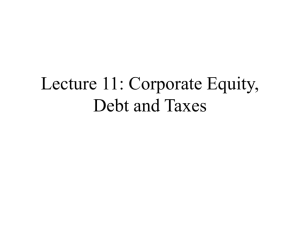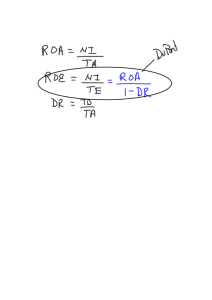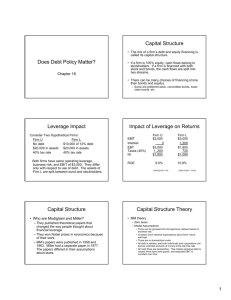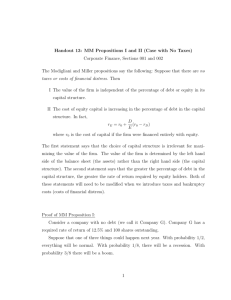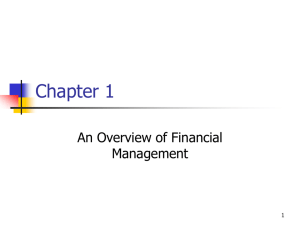Executive MBA Program Pr. Eric Jondeau – Corporate Finance Exam
advertisement
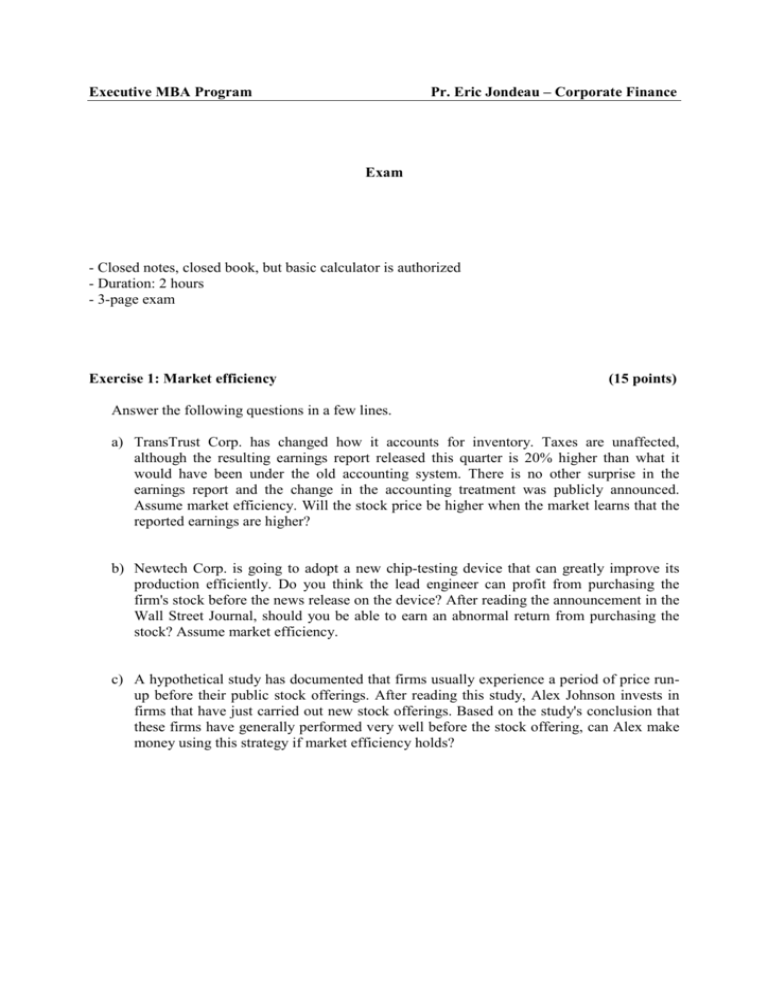
Executive MBA Program Pr. Eric Jondeau – Corporate Finance Exam - Closed notes, closed book, but basic calculator is authorized - Duration: 2 hours - 3-page exam Exercise 1: Market efficiency (15 points) Answer the following questions in a few lines. a) TransTrust Corp. has changed how it accounts for inventory. Taxes are unaffected, although the resulting earnings report released this quarter is 20% higher than what it would have been under the old accounting system. There is no other surprise in the earnings report and the change in the accounting treatment was publicly announced. Assume market efficiency. Will the stock price be higher when the market learns that the reported earnings are higher? b) Newtech Corp. is going to adopt a new chip-testing device that can greatly improve its production efficiently. Do you think the lead engineer can profit from purchasing the firm's stock before the news release on the device? After reading the announcement in the Wall Street Journal, should you be able to earn an abnormal return from purchasing the stock? Assume market efficiency. c) A hypothetical study has documented that firms usually experience a period of price runup before their public stock offerings. After reading this study, Alex Johnson invests in firms that have just carried out new stock offerings. Based on the study's conclusion that these firms have generally performed very well before the stock offering, can Alex make money using this strategy if market efficiency holds? Exercise 2: Valuation of a project (25 points) You are a successful financial analyst in a well-known investment bank. You are asked to evaluate the investment project of Veblen Inc., a client of the bank. This project has the following characteristics: • The project is expected to have an infinite life. • The initial investment is $16 million. Any depreciation on the project will be reinvested into the project as capital maintenance expenditure. There will be no working capital investment. • Earnings before interest and taxes are expected to be $8 million per year. • The corporate tax rate is τ C = 35% . • The project is financed for 50% by debt at interest rate rB = 8% . a) In order to estimate the discount rate relevant for the evaluation of the project, you have identified two firms in the same business. The characteristics of the two firms are the following: Beta of equity Debt interest rate B/(B+S) Firm A 0.8 7% 0.2 Firm B 1.1 10% 0.6 The risk free rate is 5% and the market risk premium is 8%. Calculate the cost of equity of the two firms. b) Given the cost of equity and the cost of debt, give the expression for the discount rate of a firm if it were all-equity financed ( r0 ). Calculate the discount rate of the two firms if they were all-equity financed. What may explain the difference between the r0 of the two firms? Finally, compute the relevant discount rate for Veblen, if it were all-equity financed, assuming that it is a simple average of the estimates for these two firms. c) Given the debt-to-equity ratio adopted for the project, calculate the cost of equity capital of the project ( rS ). Then, calculate the WACC relevant for the project and the NPV of the project. d) We now focus on the Adjusted NPV of the project. Compute the tax shield and deduce the APV of the project. Compare with the result obtained by the WACC approach. 2 Exercise 3: Change in the capital structure (20 points) You are asked to evaluate the capital structure of the company GoHome. The company would like to know if it should buy some own shares back by issuing additional debt. You are given the following information: Earnings before taxes Number of shares outstanding Current debt Beta of equity ( β ) Expected market return ( rm ) $153.85 million 100 shares 0 1.2 17.5% 10-year interest rate on government bonds ( rf ) 5% Corporate tax ( τ C ) 35% As you know, increasing leverage may affect the rating of the firm and consequently the interest rate on the debt. GoHome is currently rated AAA. It considers that an increase in the debt level would have the following consequences on its rating and its interest rate: Additional debt $200 million $400 million Rating AB+ Interest rate 7% 8% a) Calculate the cost of equity of the company GoHome, the cost of capital and the value of the assets of the company under the current situation. Compute the price of the shares of the company. b) For both levels of debt under consideration, compute the value of the corresponding tax shield, the value of the company as well as the value of the equity (market capitalization). Calculate the return on equity and the WACC for each debt level. c) For both levels of debt under consideration, calculate the expected price of the shares of the company and the number of shares the company may buy back. 3





